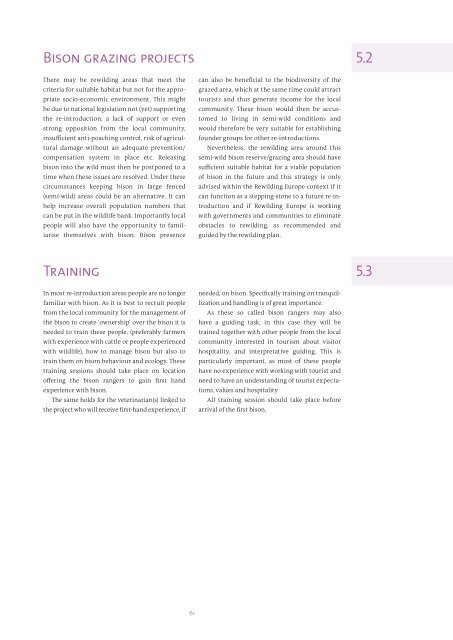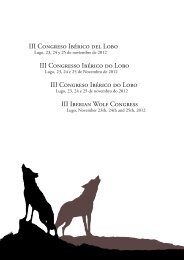4. <strong>Bison</strong> released into populationsliving in the wildDuring the pre-release phase the bison are monitoredclosely. Initially the monitoring is focused mainlyon the acclimatisation to the local environment, thenew social structure, the food intake and generalhealth status. Once released into the rewildingzone additionally the bison will be monitored onits behaviour among its herd members but alsotowards humans. If one or more of the bison showsunwanted behaviour (e.g. no flight behaviourtowards humans), has problems with adapting to thewild conditions, has a poor health status or does notfit socially in the herd then this or these bison will beexcluded for release into the wild.The decision to release the bison into the wildbased on these criteria will be taken by the localteam in consultation with the wildlife advisor of<strong>Rewilding</strong> Europe.If animals become ill during the whole pre-releasephase they will be treated accordingly andmaximum effort will be taken to cure the animals.Therefore the handling area is constructed.The herd is fit to be released into the wild, if theherd has well recovered and adapted to the localconditions, has a strong herd bonding, show goodnatural behaviour and the animals are all in goodhealth. Usually, the expected adaptation time will be± 6 months. Once released into the wild, the animalswill, in general, no longer be veterinary treated.5. Other activities important to bisonmanagement and reintroduction5.1<strong>Bison</strong> management and monitoringThe optimum time to release bison into thesemi-wild reserve or into the wild is at the beginningof the growing season so that there is maximumfood available, although some prefer to releasebison in the winter (personal communicationPerzanowski, 2003), as this can limit bison distributiondue to snow cover. However, when using thesoft release method release into the wild is best donein the late summer/early autumn as this has giventhe animals the whole summer to adapt and fattenup under controlled conditions and gives themenough time to adapt to the local conditions, andliving without human support, before the wintersets in. With this method high management costs,to feed the animals through the winter are avoided.Monitoring will be an essential componentof bison releases from the outset, not only tocheck the overall health of the population, butalso to ensure social bonding and cohesion ofthe group, particularly as individuals may havediverse origins and be unfamiliar with one otheron arrival to the overall rewilding area. <strong>Bison</strong>should therefore first be monitored in the acclimatisationzone and only when they are deemedto have recovered from transport stress, adaptedto their surroundings (including electric fencing),and display good social bonding will the group bereleased into the semi-wild reserve.In the semi-wild reserve area it will then beimportant to monitor the animals selected forrelease into the wild. Direct observations will beused to study the behaviour of the herds, and thefinal release strategy can be adapted based onthis information. As direct observation is likely tobe time-consuming, close co-operative workingwith will be achieved with universities offeringstudents the opportunity to work closely withbison. Involving many people with monitoringand research not only offers the opportunity toclosely monitor the bison but also involves manyothers in bison conservation. Several individualswithin the first release groups will be equippedwith transmitters or transponders for satelliteand/or radio-telemetry. This will help keep track ofthe bison and will help collect information on howthe bison adapt to their new environment.Poaching and illegal hunting may also be an issuein wild areas and therefore monitoring systemswill be important for effective anti-poachingmanagement. As such, recruiting bison rangersfrom among local people is preferred. The ability tolocate individual bison can also aid wildlife tourism.60
<strong>Bison</strong> grazing projects5.2There may be rewilding areas that meet thecriteria for suitable habitat but not for the appropriatesocio-economic environment. This mightbe due to national legislation not (yet) supportingthe re-introduction, a lack of support or evenstrong opposition from the local community,insufficient anti-poaching control, risk of agriculturaldamage without an adequate prevention/compensation system in place etc. Releasingbison into the wild must then be postponed to atime when these issues are resolved. Under thesecircumstances keeping bison in large fenced(semi-wild) areas could be an alternative. It canhelp increase overall population numbers thatcan be put in the wildlife bank. Importantly localpeople will also have the opportunity to familiarisethemselves with bison. <strong>Bison</strong> presencecan also be beneficial to the biodiversity of thegrazed area, which at the same time could attracttourists and thus generate income for the localcommunity. These bison would then be accustomedto living in semi-wild conditions andwould therefore be very suitable for establishingfounder groups for other re-introductions.Nevertheless, the rewilding area around thissemi-wild bison reserve/grazing area should havesufficient suitable habitat for a viable populationof bison in the future and this strategy is onlyadvised within the <strong>Rewilding</strong> Europe context if itcan function as a stepping-stone to a future re-introductionand if <strong>Rewilding</strong> Europe is workingwith governments and communities to eliminateobstacles to rewilding, as recommended andguided by the rewilding plan.Training5.3In most re-introduction areas people are no longerfamiliar with bison. As it is best to recruit peoplefrom the local community for the management ofthe bison to create ‘ownership’ over the bison it isneeded to train these people, (preferably farmerswith experience with cattle or people experiencedwith wildlife), how to manage bison but also totrain them on bison behaviour and ecology. Thesetraining sessions should take place on locationoffering the bison rangers to gain first handexperience with bison.The same holds for the veterinarian(s) linked tothe project who will receive first-hand experience, ifneeded, on bison. Specifically training on tranquillizationand handling is of great importance.As these so called bison rangers may alsohave a guiding task, in this case they will betrained together with other people from the localcommunity interested in tourism about visitorhospitality, and interpretative guiding. This isparticularly important, as most of these peoplehave no experience with working with tourist andneed to have an understanding of tourist expectations,values and hospitalityAll training session should take place beforearrival of the first bison.61



